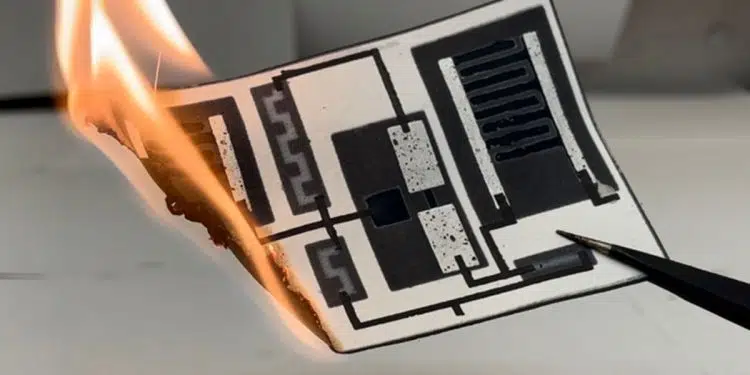Researchers from State University of New York at Binghamton reporting in ACS Applied Materials & Interfaces a prototype circuit board with fully integrated electrical components such as disposable resistors, supercapacitors or transistors on sheet of paper that can be burned or left to degrade.
Discarded electronic devices, such as cell phones, are a fast-growing source of waste. One way to mitigate the problem could be to use components that are made with renewable resources and that are easy to dispose of responsibly.
Most small electronic devices contain circuit boards that are made from glass fibers, resins and metal wiring. These boards are not easy to recycle and are relatively bulky, making them undesirable for use in point-of-care medical devices, environmental monitors or personal wearable devices.
One alternative is to use paper-based circuit boards, which should be easier to dispose of, less expensive and more flexible. However, current options require specialized paper, or they simply have traditional metal circuitry components mounted onto a sheet of paper. Instead, Choi and colleagues wanted to develop circuitry that would be simple to manufacture and that had all the electronic components fully integrated into the sheet.
The team designed a paper-based amplifier-type circuit that incorporated resistors, capacitors and a transistor. They first used wax to print channels onto a sheet of paper in a simple pattern. After melting the wax so that it soaked into the paper, the team printed semi-conductive and conductive inks, which soaked into the areas not blocked by wax. Then, the researchers screen-printed additional conductive metal components and casted a gel-based electrolyte onto the sheet.
Tests confirmed that the resistor, capacitor and transistor designs performed properly. The final circuit was very flexible and thin, just like paper, even after adding the components. To demonstrate the degradability of the circuit, the team showed that the entire unit quickly burned to ash after being lit on fire. The researchers say this represents a step toward producing completely disposable electronic devices.
Abstract
Humanity’s excessive production of material waste poses a critical environmental threat, and the problem is only escalating, especially in the past few decades with the rapid development of powerful electronic tools and persistent consumer desire to upgrade to the newest available technology. The poor disposability of electronics is especially an issue for the newly arising field of single-use devices and sensors, which are often used to evaluate human health and monitor environmental conditions, and for other novel applications. Though impressive in terms of function and convenience, usage of conventional electronic components in these applications would inflict an immense surge in waste and result in higher costs.
This work’s primary objective is to develop a cost-effective, eco-friendly, all-paper, device for single-use applications that can be easily and safely disposed of through incineration or biodegradation. All electronic components are paper-based and integrated on paper-based printed circuit boards (PCBs), innovatively providing a realistic and practical solution for green electronic platforms. In particular, a methodology is discussed for simultaneously achieving very tunable resistors (20 Ω to 285 kΩ), supercapacitors (∼3.29 mF), and electrolyte-gated field-effect transistors on and within the thickness of a single sheet of paper. Each electronic component is completely integrated into functionalized paper regions and exhibits favorable electrical activity, adjustability, flexibility, and disposability. A simple amplifier circuit is successfully demonstrated within a small area and within the thickness of a single sheet of paper, displaying component versatility and the capability for their fabrication processes to be performed in parallel for efficient and rapid development.
JOURNAL: ACS Applied Materials & Interfaces
ARTICLE TITLE: Integrated Papertronic Techniques: Highly Customizable Resistor, Supercapacitor, and Transistor Circuitry on a Single Sheet of Paper































